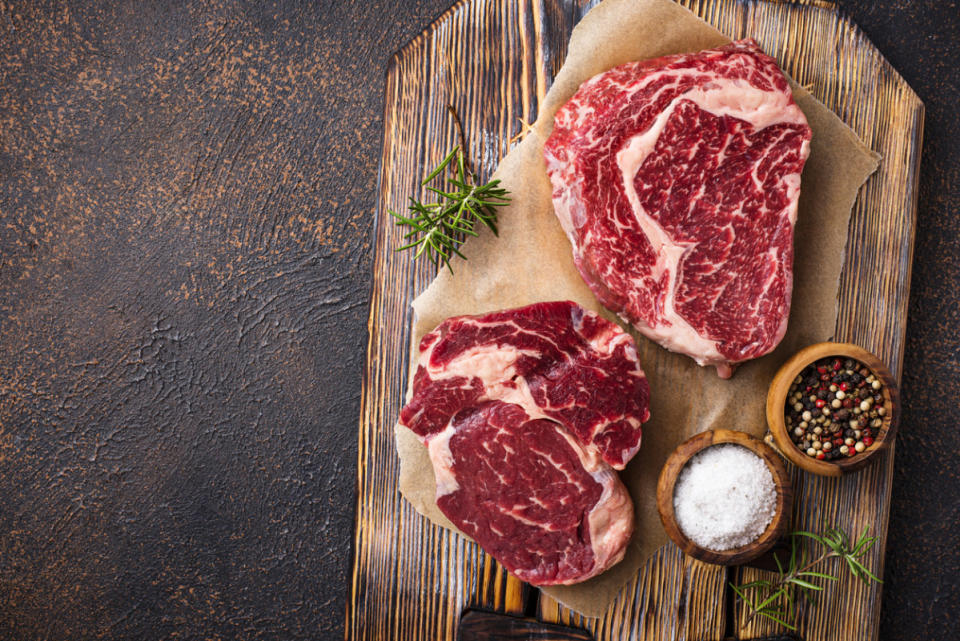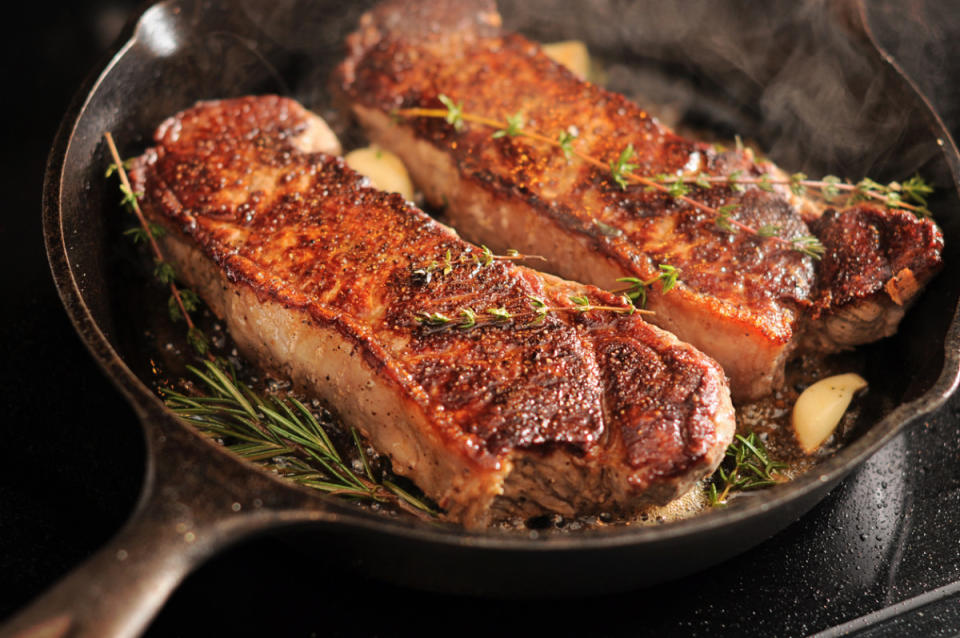The Absolute Best Way to Cook a Tender, Juicy, Never Ever Dry Steak

Steak sliced on cutting board with butter on top
There are flowers, chocolate and gifts to think about on Valentine’s Day, then there’s the all-important romantic dinner. Of course, dining out with your beloved for Valentine’s Day is lovely, but another way to really bring the romance? Treat them to an intimate steak dinner at home.
And while cooking a steak in a ripping hot cast iron skillet is a great method, it also requires that you pay close attention, which can sometimes be a little bit challenging as you try to make sure all of your steak sides are ready and make your sweetie a little pre-dinner cocktail.
For a foolproof, more hands-off way to cook steak, we really like the reverse-sear method, which has become increasingly popular with chefs, other food pros and home cooks. Reverse searing creates the juiciest, most tender steak with a perfectly caramelized crust and it's way more hands-off because most of the cooking is done in the oven. Here's everything you need to know about this clever way of cooking a great steak—for Valentine's Day or any day.
Related: 55 Best Steakhouse-Inspired Steak Recipes

iStock
What Is Reverse Searing?
If you’ve ever cooked steak before, you were probably taught to sear it first to “lock in the juices,” then finish it in the oven. But as New York Times columnist and author of The Food Lab: Better Home Cooking Through Science writes “these days, we know that this statement is definitively false.” What does searing do? It adds flavor. And many pros now swear by starting your steaks in a low-temperature oven*, then searing them at the end of the cooking process, instead of at the beginning for better results.
When the steaks reach your desired doneness in the oven, you sear them in a hot pan on the stovetop to get that beautiful, tasty brown crust on the outside. This is what it means to reverse sear a steak.
*See below for oven temperature recommendations.
Related: How to Cook Prime Rib Like a Pro, According to Pat LaFrieda, America's Most Celebrated Butcher
What's So Great about Reverse Searing a Steak?
Many steak enthusiasts and modern chefs, including Lopez, have found that starting your steaks at a low temperature in the oven helps them cook more evenly and results in better browning.
“It gives you better control and a more foolproof method… it slows everything down, buys you a lot more time and your margin of error is bigger,” says Serious Eats Managing Culinary Director Daniel Gritzer in his video demonstration of the method.
“It sort of borrows a page from the sous vide book,” he adds. That low and slow method ensures
This means there's less risk of overcooking the meat and a juicier, more tender steak on the inside.
“The other really great thing about the reverse sear method is because the steaks are hanging out in a dry, hot oven, the surface will continue to dry out,” explains Gritzer. Why does this matter? A dryer surface means less moisture in your pan when you sear, which will give you a better, more richly caramelized crust.
Related: The Easy Homemade Steak Sauce You're Gonna Want to Put on Everything
Oven Temperature Guidelines and Cook Times for Reverse-Seared Steaks
First, don’t forget to season your meat generously with salt and pepper before putting them in the oven! (If you really want to outdo yourself, Lopez recommends setting steaks on a wire rack set in a rimmed baking sheet and refrigerating, uncovered, overnight to dry them out for an even better sear).
In his article on this method, Lopez provides the following recommended oven temperatures and cook times for thick-cut steaks, about 1 1/2–inches thick (such as ribeye, strip, porterhouse, T-bone, tri-tip, or filet mignon):
Rare: 120°F for 20 to 25 minutes
Medium-Rare: 130°F for 25 to 30 minutes
Medium: 140°F for 30 to 35 minutes
Medium-Well: 150°F for 35 to 40 minutes
Related: The Absolute Best Marinated Flank Steak Recipe
How to Check the Doneness of a Reverse-Seared Steak
Gritzer likes to use a probe thermometer to track the internal temperature of the steaks as they cook. Just like with an instant-read thermometer, be sure to insert it in the center of the steak and if you’re cooking bone-in steaks, make sure not to put it up against the bone, which will throw off your temperature readings.
“If you don’t have a probe thermometer, it’s ok, though. You can just use an instant-read thermometer,” he says.
With reverse searing, you have to keep in mind that you’re going to cook the steaks a bit more after they come out of the oven, so you’ll want to pull them out when they're a bit lower than the final temperature you're aiming for.
Speaking of, here’s an at-a-glance guide to Gritzer's recommended temperatures to look for to know when to pull your steaks out of the oven:
Rare: 105°F
Medium-rare: 115°F
Medium: 125°F
Medium-well: 135°F

iStock
Searing Tips for Finishing Your Steak Perfectly
Gritzer likes to use a cast iron pan and adds 1 tablespoon of oil, getting it “smoking hot” before adding the steaks to the pan. This is so they will sear as quickly as possible without cooking the inside of the steaks too much.
“The whole point of this method is to have a nice, even doneness,” he explains.
When he adds the steaks to the pan, he also likes to throw in a little butter for more flavor—as well as a sprig of thyme and garlic—but this step is totally optional.
“Swirl that around, press it down, make sure the steaks have full contact with your pan” for an even sear and then flip it after 45 seconds to one minute and cook another 45 seconds to one minute to sear the other side. Sear your edges for a few seconds. Then they’re done!
The other great thing about the reverse searing method is that your steaks don’t need to rest because they were cooked in the oven at such a low temperature. “It’s so low and slow coming up to temperature that you don’t have the same issues as when you’re doing a high heat method of giving the steak a chance to reabsorb the juices,” adds Gritzer. So you can serve and/or slice whenever you’re ready.
